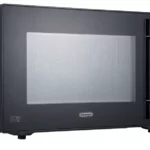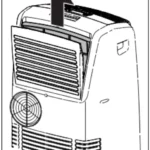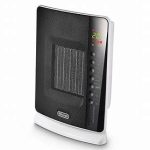
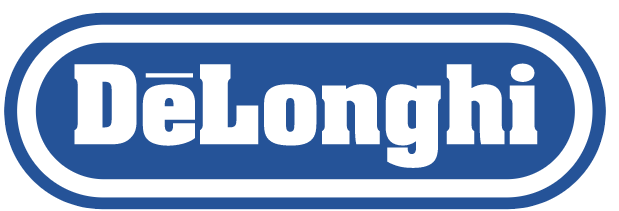
DeLonghi PACEL376HGRFK Portable Air Conditioner

What's Included?

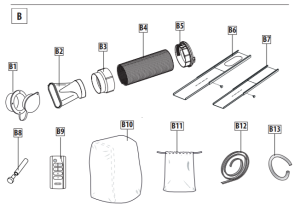
Important safeguard
- The appliance is not intended for use by persons (including children) with reduced physical, sensory or mental capabilities, or lack of experience and knowledge, unless they have been given supervision or instruction concerning use of the appliance by a person responsible for their safety.
- Children should be supervised to ensure that they do not play with the appliance.
- If the SUPPLY CORD is damaged, it must be replaced by the manufacturer, its service agent or similarly qualified persons in order to avoid a hazard.
- The appliance shall be installed in accordance with national wiring regulations.
As the appliance is powered by electricity, the possibility of electrical shock cannot be excluded. The following safety precautions must therefore be followed: - After removing the packaging, check the condition of the appliance. If in doubt, do not use the appliance and contact professionally qualified personnel.
- Before use, always check the condition of the power cord.
- It is dangerous to modify or alter the characteristics of the appliance in any way.
- This appliance must be connected to an efficient “grounding” system. Have the electrical system checked by a qualified electrician.
- Before each cleaning or maintenance operation, always disconnect the plug from the power outlet.
- Never submerge the appliance in water.
- Do not use the appliance outdoors.
- Do not obstruct the entrances and exits of air.
- When the appliance is connected to the mains, keep the following safety rules in mind:
- Do not touch the appliance with wet or damp hands;
- Do not use the appliance with bare or wet feet;
- Do not pull on the power cord or appliance to detach the plug from the power outlet;
- Do not move the appliance by pulling the power cable.
- keep the appliance far from the reach of children;
- Do not insert foreign bodies into the appliance;
- Do not insert metal objects into the apertures.
Danger! Rotating parts; contact with the internal fan could cause electric shock or injury. - do not leave the appliance exposed to atmospheric agents;
- If you wish to permanently eliminate the appliance, after disconnecting the plug from the power outlet it is recommended to make it unusable by severing the power cord.
- In the event of a fault and/or malfunction, turn the appliance off without tampering with it. For all repairs, contact an authorized technical service centre only and request the use of original spare parts and accessories.
- Avoid the use of power cord extensions.
Designated use
This appliance must be used exclusively in domestic environment and for the intended purpose for which it was designed. All other uses are considered improper and therefore hazardous. The manufacturer shall not be held liable for any damage caused by improper, erroneous and irresponsible use, and/or due to repairs made by unqualified personnel.
Installing the appliance
- The appliance must be installed in compliance with national standards regulating electrical systems.
- Do not operate your air conditioner in a wet room such as a bathroom or laundry room.
- Do not install the appliance in rooms containing gas, oil or sulphur or near sources of heat.
- Do not use the appliance on sloping surfaces.
- Keep the appliance at least 20” (52cm) away from flammable substances (alcohol, etc.) or pressurised containers (e.g. aerosol cans).
- Do not rest objects on top of the appliance.
- When transporting, the appliance must be kept upright. If this is not possible secure the unit at.
- an angle, do not lie it horizontally.
- Before transporting the unit, drain the unit.
- After transportation, wait at least 6 hours before
- switching the unit on.
Enviromental information
- The materials used for packaging can be recycled. You are therefore recommended to dispose of them in special differentiated waste collection containers.

- Thoroughly read all of the warnings.
- When defrosting and cleaning the appliance, do not use any tools other than those recommended by the manufacturing company.
- The appliance shall be stored in a well-ventilated area;
- The appliance shall be stored in a room without continuously operating open flames (for example an operating gas appliance) and ignition sources (for example an operating electric heater).
- Do not burn any part of the appliance.
- Refrigerant gases can be odorless.
- This appliance contains R32 refrigerant gas. (For more details on the refrigerant, see back cover).
- Do not puncture any part of the refrigerant circuit.
- The servicing shall be performed only as recommended by the manufacturer.
- The appliance must be stored in a safe place in order to prevent damage to the unit.
- Individuals who operate or work on the refrigerant circuit must have the appropriate certification issued by an accredited organisation that ensures competence in handling refrigerants according to a specific evaluation recognized by associations in the industry.
- Repairs must be performed based on the recommendations from the manufacturing company. Maintenance and repairs that require the assistance of other qualified personnel.
must be performed under the supervision of an individual specified in the use of flammable refrigerants.
GENERAL INFORMATION
Instruction for Use
Read all the Instruction for Use carefully before using the appliance. Failure to follow this Instruction for Use may result in burns or damage to the appliance.
The manufacturer is not liable for damage deriving from failure to respect this Instruction for Use.
WARNING: Changes or modifications not expressly approved by the party responsible for compliance could void the user’s authority to operate the equipment.
Please note
These safety warnings are valid for all De’Longhi air conditioners.
If the appliance is passed to other persons, they must also be provided with this Instruction for Use.
This appliance is fitted with a special safety
device. When the compressor switches off, this
device prevents it from switching on again for at least 3 minutes.
BEFORE USE
Important
Store the packaging material (plastic bags, styrofoam) far from the reach of children. CHOKING HAZARD. The appliance might contain small parts. Some of those small parts might be required to get disassembled during cleaning and maintenance operations. Handle with care and keep small parts out of reach of children.
Checking the appliance
After removing the packaging, make sure the product is complete and undamaged and that all accessories are present. Do not use the appliance if it is visibly damaged. Contact De’Longhi Customer Services.
Save these instructions
This product is for household use only
INTRODUCTION
Thank you for choosing a De’Longhi product. Please take a few moments to read the instructions to avoid risks or damage to the appliance.
DESCRIPTION
Description of the appliance
- A1 Air outlet grid
- A2 Control panel
- A3 Handles
- A4 Wheels
- A5 Remote control signal receiver
- A6 Remote control storage
- A7 Filter
- A8 Air intake grille
- A9 Air exhaust hose housing
- A10 Air intake grille
- A11 Lower drainage hose with cap
- A12 Power supply cable
- A13 Upper drainage hose with cap
Description of accessories
- B1 Wall flange with cap
- B2 Window outlet vent
- B3 Hose adapter to wall flange/window outlet vent
- B4 Air exhaust hose
- B5 Hose adapter to unit
- B6 Window bracket with locking pin
- B7 Additional window bracket with locking pin
- B8 Water drain tube with cap
- B9 Remote control
- B10 End of season dust cover (on some models only)
- B11 End of season accessories bag (on some models only)
- B12 Foam stripping
- B13 Evaporator water drain tube
Electrical connection
Before plugging the appliance into the outlet, check that:
- The outlet’s power supply corresponds to the value indicated on the rating label on the back of the appliance;
- The outlet and electrical circuit are adequate for the appliance;
- The outlet is a 3-hole grounded outlet . If this is not the case, you must choose another outlet. Failure to follow these important safety instructions absolves the manufacturer of all liability.
- If it becomes necessary, the power cable must be replaced by a qualified professional only.
- The instructions below will enable you to prepare your air conditioner for operation as efficiently as possible. Before use, make sure the air intake and outlet grilles are unobstructed.
USE
Note: This appliance features an auto evaporative function to remove excess condensate water during cooling and dehumidifiying modes.
AIR CONDITIONING WITH WALL INSTALLATION
For optimal results set up your appliance in this way:
- Screw the hose adaptor B3 and B5 to the hose’s end B4 as shown in figure 1a.
- Fit the assembled air exhaust hose adapter B5 in the housing at the back of the appliance. Align the open lock symbol on the adapter (B5) with the arrow on the back of the unit. Turn adapter counter clockwise until the closed lock symbol is aligned with the arrow, as shown in figure 1b.
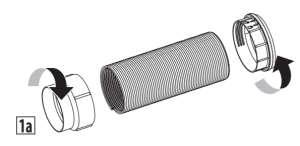
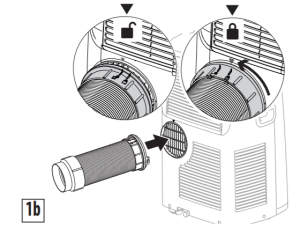
- Respect the distances given in figure 2 below.
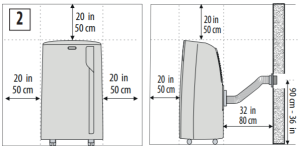
Proceed as follows:
- Drill a hole ø 5,25 inches (134 mm) in an outside wall or through a wooden kickboard. Respect the dimensions and height of the hole given in figure 2 and 3.
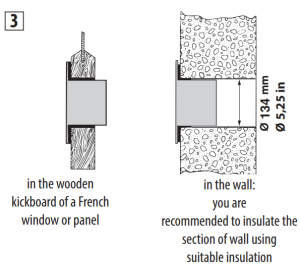
- Fit the wall flange B1 into the hole.
- Fit the assembled hose B3-B4-B5 into the wall flange B1.
- When the air hose B4 is not connected, the drilled hole can be closed with the flange cap B1.
- When installing the air conditioner, you should leave a door slightly open little as 1/2“(1 cm) to guarantee correct ventilation and room pressure.
- Keep the air hoses as short and free of curves as possible to avoid constrictions.
Note
As special tools are required for this type of installation, we suggest you have the appliance installed by specialized personnel.

- Fit the wall flange B1 into the hole.
- Fit the assembled hose B3-B4-B5 into the wall flange B1.
- When the air hose B4 is not connected, the drilled hole can be closed with the flange cap B1.
- When installing the air conditioner, you should leave a door slightly open little as 1/2“(1 cm) to guarantee correct ventilation and room pressure.
- Keep the air hoses as short and free of curves as possible to avoid constrictions.
Note:
As special tools are required for this type of installation, we suggest you have the appliance installed by specialized personnel.
AIR CONDITIONING WITH WINDOW INSTALLATION
You can also set up in a double-hung window:
- Place the window bracket in the window sill, extend the bracket fully within the window frame, fix the bracket in place using the locking pin. Attach the provided foam stripping B12 to the top of the window bracket and then lower the window onto the bracket. (Should the window bracket be too large for the window, the plastic can be cut with a saw by a qualified professional.)
- Fit the air exhaust hose B4 in the relevant housing located on the rear side of the appliance using hose adapter B5. Align the open lock symbol on the adapter B5 with the arrow on the back of the unit. Turn adapter counter clockwise until the closed lock symbol is aligned with the arrow, as shown in figure 1b.
- Connect the window outlet vent B2 to the other end of the exhaust hose using hose adapter B3.
- Insert the window outlet vent B2 of the exhaust hose into the slot of the window bracket (fig. 4).
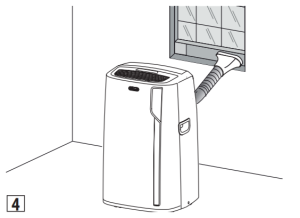
Other set-up methods:
- Thanks to the locking pins, it’s possible to use the window bracket also for sliding windows. Position the hole of the bracket so to allow a correct installation of the exhaust hose (see fig. 5).
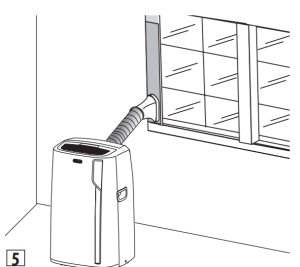
- If you have a casement window (figure 6) proceed as follows:
- Fit the assembled air exhaust hose B4 in the relevant housing located on the rear side of the appliance, using hose adapter B5. Align the open lock symbol on the adapter B5 with the arrow on the back of the unit. Turn adapter counter clockwise until the closed lock symbol is aligned with the arrow, as shown in figure 1b. Then, apply the window outlet B2 to the air exhaust hose B4 and place it outside the window to exhaust the hot air.
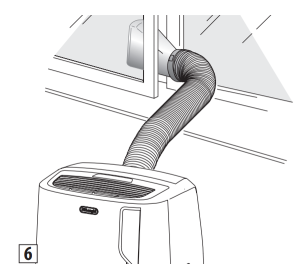
OPERATING FROM THE CONTROL PANEL
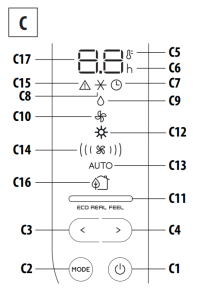
DESCRIPTION OF THE CONTROL PANEL
- C1 ON/STAND-BY (on/off) key
- C2 Mode selection key (air conditioning, dehumidifying, fan, heating)
- C3 Decrease key
- C4 Increase key
- C5 Temperature indicator
- C6 Timer hour indicator
- C7 Timer symbol
- C8 Air conditioning symbol
- C9 Dehumidifying symbol
- C10 Fan symbol
- C11 ECO REAL FEEL indicator
- C12 Heating symbol (on some models only)
- C13 Auto air flow indicator
- C14 Air flow indicators
- C15 Alarm symbol
- C16 ECO REAL FEEL symbol
- C17 Set temperature display, programmed on/off time
OPERATING FROM THE CONTROL PANEL
TURNING THE APPLIANCE ON/OFF
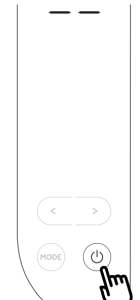
Before plugging in the appliance, check the caps on back of the unit are correctly inserted on drainage hose A11 and A13.
Insert the plug in the socket.
Two dashes appear on the display indicating that the appliance is in stand-by. Touch the (C1) key to turn on the appliance. When the appliance comes on, the last function set before it was shut off is activated.
NOTE: After a few seconds of inactivity, the brightness of the control panel will be automatically reduced and in the next few minutes it will be further reduced. To turn the appliance off, touch the key.
Note: Never turn off the air conditioner by simply pulling the plug. Touch the key in order to put your air conditioner in stand-by and wait a few minutes before pulling the plug. In this manner, the appliance can perform operating status checks.
MODE SELECTION
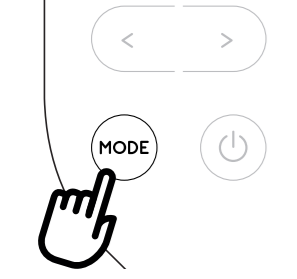
To select the desired operating mode, touch repeatedly the MODE key until the desired function is selected.
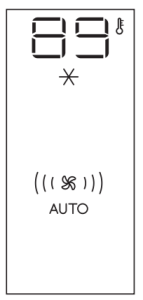
AIR CONDITIONING MODEThis is ideal for hot and humid weather when the room needs to be both cooled and dehumidified.
To correctly set this mode:
- Touch repeatedly the MODE key until the air conditioning symbol appears. The display will show the symbol .
- To change to the desired temperature, touch the or key.
Note: The most suitable temperatures, during the summer range from 75 to 81°F. However, setting the temperature significantly lower than the outdoor
temperature is not recommended. In conditioning mode, the air flow can be selected only from the remote control.
DEHUMIDIFYING MODE
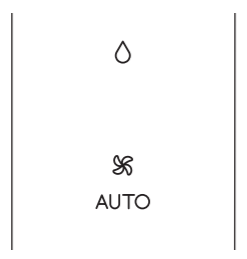
This is ideal for reducing humidity in the room (spring and autumn, damp rooms, rainy periods, etc). For this type of use, the appliance must be set up same as in the air conditioner mode. That is, the air exhaust hose B4 must be fitted to the appliance to allow the humidity to be discharged outside. To correctly set this mode:
- Touch repeatedly the MODE key until the dehumidifying symbol appears.
- The appliance automatically chooses the best air flow.
Note
In case of high ambient humidity, it is possible to drain the condensation continuously by applying the tube supplied B13 to the upper drainage hose A13 (fig. 7) and thus allowing the water to flow into a container.
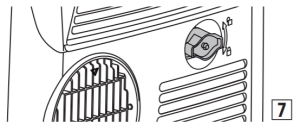
Unscrew the cap by following the directions and inserting the tube. Pay attention that water does not overflow onto the floor (fig. 8). If the connector is not in use, to avoid overflow onto the floor, remember to screw the cap back into place and the drainage hose is not obstructed.
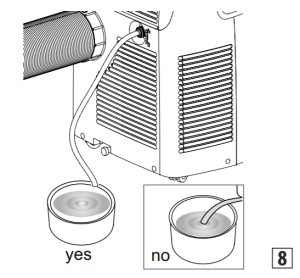
FAN MODE
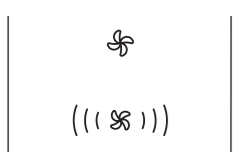
When using this mode, the air exhaust hose B4 does not need to be attached to the appliance
To correctly set this mode:
- Touch repeatedly the MODE key until the fan symbol appears.
- Select the desired air flow by touching the increase C4 or decrease C3 buttons.
The air flows available are



HEATING MODE (on some models only)

This is ideal in spring and autumn when outdoor temperatures are not particularly severe. For this mode, the appliance should be prepared in the same way as for air conditioning, with the air exhaust hose B4 attached.
To set this mode:
- Touch repeatedly the MODE button until the heating symbol is displayed.
- Touch increase C4 or decrease C3 buttons to adjust the desired temperature.
Notes
- In this mode, the air flow is selected automatically by the appliance and cannot be set manually.
- When operating in very cold rooms, the appliance defreezes automatically, momentarily interrupting normal operation. In this case, “Lt “ appears on the display. During this operation, it is normal for the noise made by the appliance to change.
- In this mode, you may have to wait a few minutes before the appliance starts providing warm air.
- In this mode, the fan may operate for short periods, even though the set temperature has already been reached.
- If the display comes on and shows the “HL” alarm, empty the internal tray following the instructions in the Section “End of Season operations”. At the end, touch again the button to restore the heating function.
ECO REAL FEEL FUNCTION (available only from remote control)

ECO REAL FEEL is the innovative
De’Longhi technology that works simultaneously on temperature reduction and humidity control, securing the best comfort level.
With traditional systems, during working time, optimal comfort conditions may be reached but not secured over time. With ECO REAL FEEL, once optimal comfort is reached, the portable air conditioner automatically modulates the compressor and air flow, to keep it over time. To activate the function, press the Eco Real Feel button.
The ECO REAL FEELsymbol C16 appears. Please note: For this type of use, the appliance must be set up same as in the air conditioning mode. After approx. 1 minute, the
ECO REAL FEEL indicator C11 turns on. It changes color when approaching the best comfort level (see following diagram).

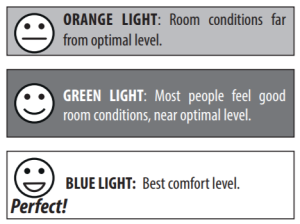
The well-being feeling is a subjective condition: for this reason, different people may judge differently the same environmental conditions. In particularly severe environmental
conditions (high temperature or humidity outside,
poor insulation, too many people, high heat in the room, strong exposure to the sun, etc…) this device may not be able to reach the best comfort level.
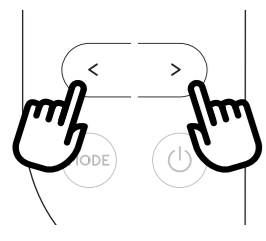
OPERATING FROM THE REMOTE CONTROL
- Remove the cover on the rear of the remote control;
- Insert or replace the batteries with two new LR03 “AAA” 1.5V batteries, inserting them correctly (see the directions inside the battery compartment);
- Replace the cover..
Please note: If the remote control unit is replaced or discarded, the batteries must be removed and disposed of in accordance with current legislation as they are harmful to the environment. Do not mix old and new batteries. Do not mix alkaline, standard (carbon-zinc) or rechargeable (nickel-cadmium) batteries. Do not dispose of batteries in fire. Batteries may explode or leak. If the remote control is not be used for a certain length of time, remove the batteries.
USING THE REMOTE CONTROL
- Point the remote control at the receiver A5 on the air conditioner. The remote control must be no more than 16ft/5 meters away from the appliance (without obstacles between the remote control and the receiver).
- The remote control must be handled with care. Do not drop it or expose it to direct sunlight or sources of heat.
Please note: The remote control can be safely stored in the appropriate compartment A6.
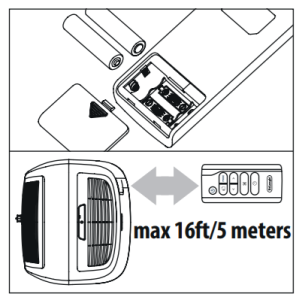
DESCRIPTION OF THE REMOTE CONTROL
D1) ON/STAND-BY button
D2) Air flow selection button
D3) ECO REAL FEEL button
D4) Timer button
D5) MODE button
D6-D7) Decrease/ Increase button.
SELECTING THE OPERATING MODES
Most of the commands available on the remote control correspond to those on the appliance control panel A2.
SELECTING THE TEMPERATURES
In air conditioning and heating modes, press increase/decrease keys to select the desired temperature.
SELECTING THE AIR FLOW
In air conditioning and fan modes, press air flow selection button on remote control to select the desired air flow. The air flow available are: Minimum air flow: when maximum quiet
operation is desired. Medium air flow: when the noise level needs to be low but with a good comfort level. Maximum air flow: for maximum performance.
The appliance automatically chooses the air flow based on the temperature selected and the environmental conditions (This is available only in the air conditioning mode).
ECO REAL FEEL FUNCTION
To activate this function, push button D3 on the remote control.See description of the function on page 10.
SETTING THE TIMER
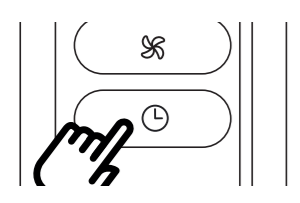
How to program delayed shut down
- While the appliance is on in any operating mode, delayed shut down can be programmed.
- Press the timer button D4: the timer symbol C7 and hours C6 light up.
- Press the timer key until the desired number of hours to shut down appears on the display (1,2,4,6,8,12 hours).
A few seconds after the timer is set, the setting is memorized and the display shows the operating mode and the timer symbol stays lit.
Once the set time is elapsed, the air conditioner goes into standby.
To cancel the timer program, press the timer button D4 twice. The timer symbol C7 will go off.
Note: Once the timer has been activated, by pressing the timer key only one time, the remaining hours to shut down will be displayed.
How to program delayed start up
- Plug in the appliance and set to standby.
- Press the timer button D4: the timer symbol C7 and hours C6 light up.
- Press the timer key until the desired numbers of hours to start up appears (1,2,4,6,8,12 hours).
When the set time is elapsed, the appliance will start to operate in the same operating mode that was previously set. To cancel the timer program, press the timer button D4 twice. The timer symbol C7 will go off.
NOTE: Once the timer has been activated, by pressing the timer key only one time, the remaining hours to the start up will be displayed.
Notes:
- This equipment has been tested and found to comply with the limits for a Class B digital device, pursuant to part 15 of the FCC Rules. These limits are designed to provide reasonable protection against harmful interference in a residential installation.
- This equipment generates, uses and can radiate radio frequency energy and, if not installed and used in accordance with the instructions, may cause harmful interference to radio communications. However, there is no guarantee that interference will not occur in a particular installation. If this equipment does cause harmful interference to radio or television reception, which can be determined by turning the equipment off and on, the user is encouraged to try to correct the interference by one or more of the following measures:
– Reorient or relocate the receiving antenna.
– Increase the separation between the equipment and receiver.
– Connect the equipment into an outlet on a circuit different from that to which the receiver is connected.
– Consult the dealer or an experienced radio/TV technician for help. Changes or modifications not expressly approved by the party responsible for compliance could void the user’s authority to operate the equipment. - This device complies with Part 15 of the FCC Rules. Operation is subject to the following two conditions: (1) this device may not cause harmful interference, and (2) this device must accept any interference received, including interference that may cause undesired operation.
- This Class B digital apparatus complies with Canadian ICES-003.
SELF-DIAGNOSIS
The appliance has a self diagnosis system to identify a number of warning/malfunctions. Error messages are displayed on the appliance display.
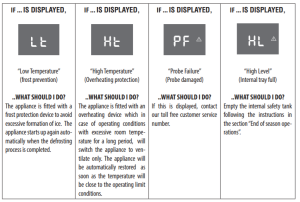
TIPS FOR CORRECT USE
- To ensure optimal results from your air conditioner, follow these recommendations:
Close the windows and doors in the room to be air conditioned When installing the air conditioner semi-permanently, you should leave a door slightly open (as little as 1/2’’ inch. (1 cm)) to guarantee proper ventilation.
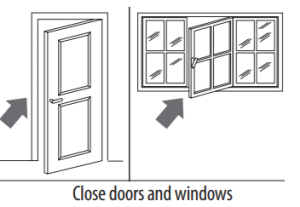
- Never use the appliance in very damp rooms (laundries for example).
- Protect the room from direct exposure to the sun by partially closing curtains and/or blinds to make the appliance much more economical to run.
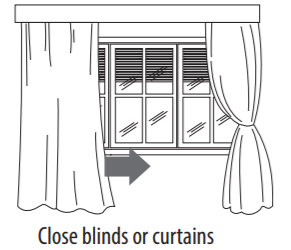
Close blinds or curtains
- Never use the appliance outdoors.
- Make sure there are no heat sources in the room.
- Make sure the air conditioner is standing on a level surface.

do not cover the appliance
- Never rest objects of any kind on the air conditioner.
- Never obstruct the air intake or outlet grilles.
CLEANING
Before cleaning or maintenance, turn the appliance off by using the button, then unplug from the outlet.
CLEANING THE CABINET
You should clean the appliance with a slightly damp cloth then dry with a dry cloth. For safety reasons, never wash the air conditioner with water. Precautions
Never use petrol, alcohol or solvents to clean the appliance. Never spray insecticide liquids or similar.
CLEANING THE BIO SILVER AIR FILTER (If fitted)
If the filter is dirty, air circulation is compromised and the efficiency of the appliance decreases.
It is therefore good practice to clean the filter at regular intervals. The frequency depends on the duration and conditions of operation. If the unit is used constantly or systematically, you are recommended to clean the filter once a week.
The filter is housed in the intake grille.Remove the grille to access the filter. To clean the filter, it will need to be extracted as shown in fig. 9.
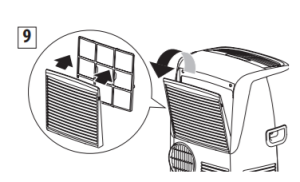
Use a vacuum cleaner to remove any dust deposited on the filter. If it is very dirty, submerge it into warm water and rinse it several times. The water temperature must be kept below 104° F (40°C). After washing the filter, allow it to dry completely before repositioning it.
The BioSilver filter helps capture dust and pollen and helps reduce the growth of bacteria and mold on the filter.
CHECKS AT THE START OF THE SEASON
Make sure the power cable and socket are in perfect condition and make sure the grounding system is sufficient. Comply strictly with the installation standards.
END OF SEASON OPERATIONS
To drain all water from the circuit, remove the cap A11 from the drainage on the back of the appliance and allow the water to drain out into a basin (fig. 10).
To facilitate this operation, at the start of the season, it’s possible to apply the water drain hose with cap B8.
In order to properly storage the appliance at the end of the season, we suggest you cover it with the supplied end of season dust cover B10 and you put the accessories in the relevant
end of season accessories bag B11.
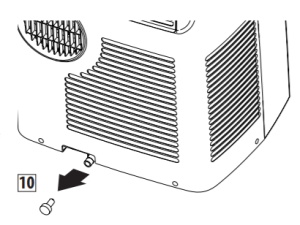
When the appliance is empty, replace the cap.
Clean the filter and dry thoroughly before putting back. Unit should be stored in large, well ventilated area.
TECHNICAL SPECIFICATIONS
Power supply voltage see rating label
Max. absorbed power during air conditioning “ Refrigerant “ Cooling capacity
LIMIT CONDITIONS
Room temperature for
air conditioning 64 ÷ 95°F (18° ÷ 35°C)
Room temperature for
heating (on some models only) 50 ÷ 77°F (10 ÷ 25°C)
Maximum relative humidity : 80% RH
Transport, filling, cleaning, recovery and disposal of refrigerant should be performed by a technical service centre appointed by the manufacturer only.
The appliance should be disposed of by a specialist centre appointed by the manufacturer only.
TO AVOID DAMAGE TO THE UNIT:
NEVER TRANSPORT OR TURN THE APPLIANCE UPSIDE DOWN OR ON ITS SIDE. IF THIS OCCURS, WAIT 6 HOURS BEFORE TURNING THE APPLIANCE ON, 24 HOURS IS RECOMMENDED. After the unit has been on its side, oil needs to return to the compressor to ensure proper function. Without allowing the unit this time (6-24 hours) the unit may function for only a short time, and then the compressor will break down from lack of oil.
ELECTRICAL CONNECTION
This appliance is equipped with a 3 prong grounded plug. The plug must be connected into an outlet that is properly installed and grounded in the accordance with all local codes and ordinances. Do not modify the plug provided with the appliance. If it will not fit the outlet, have a proper outlet installed by a qualified electrician or relocate the unit to a proper outlet. If the household electrical supply does not meet the above specifications, or if you are not sure your home has an effective electrical ground, have a qualified electrician or your local electrical utility company check it and correct any problems.
SAFETY PLUG
The appliance is fitted with a safety plug to protect the power cable. If power is cut off, unplug from the outlet and make sure the power cable is undamaged. If the cable is damaged, call the service center immediately. If power cuts off frequently and the power cable is undamaged, contact a qualified electrician.
OPERATION OF THE SAFETY PLUG
If the safety device incorporated in the plug trips and cuts off the power supply, check that the power cable and plug are not damaged. If the power cable is undamaged, to restore operation press the “RESET” button. To verify correct operation of the plug, press the “TEST” button periodically and make sure the appliance disconnects. If this is not the case, contact the service center. To restore operation, press the “RESET” button.
TROUBLESHOOTING
Please check the following points before calling the toll-free customer service number.
| PROBLEMS | CAUSES | SOLUTIONS |
| The air conditioner does not turn on | lt is not plugged in | plug it in |
| there is no power | wait for at least 3 minutes and try again | |
| the internal protection device was triggered | call the help center | |
| The air conditioner works for a short period of time | the air exhaust hose is obstructed or bent | correctly position the air exhaust hose, limiting the length and curves as much as possible and avoiding any obstructions |
| an obstruction is impeding air exhaust outside | identify and remove the obstacles that impede air exhaust outside | |
| The air conditioner runs but does not cool the room | windows, doors, drapes open | close the windows, doors and drapes, keeping in mind the “recommendations for proper use” |
| there is some heat source in the room (oven, hair dryer, etc.) | eliminate the heat source | |
| the air exhaust hose is disconnected from the appliance | attach the air exhaust hose to the housing on the back of the appliance (fig.1) | |
| dust filters clogged | clean or replace the filters as previously described | |
| During operation there is an unpleasant odor in the room | dust filters clogged | clean or replace the filters as previously described |
| The air conditioner does not work for about 3 minutes from restart | to protect the compressor there is an internal device that delays startup for about 3 minutes from restart | wait the recommended time and try again |
| The internal tank is full | high ambient humidity | apply the evaporator water drain tube supplied (B13) to the upper drainage hose (A13), thus allowing the water to flow into a container. Pay attention the water does not overflow on to the floor. |
| One of the following messages is displayed:
Lt/ Ht /P /HL |
the appliance has a self-diagnosis system that identifies some operating errors | refer to the SELF-DIAGNOSIS chapter |
What is the difference between the DeLonghi PACEL376HGRFK and the DeLonghi PACEL376HG?
The DeLonghi PACEL376HGRFK is designed to cool a room up to 350 square feet, while the DeLonghi PACEL376HG is designed to cool a room up to 300 square feet.
Does this air conditioner have a remote control?
Yes, it does.
How do I clean the air conditioner?
You can clean the air conditioner by wiping it down with a damp cloth.
How do I know when my air conditioner needs to be serviced?
If your air conditioner is not cooling as well as it used to, or if you hear strange noises coming from it, contact a professional for servicing.
What are some of the features of this air conditioner that make it so unique?
This air conditioner has an easy-to-use remote control, and it also has an automatic restart function in case of power failure. It also has a sleep mode that allows you to set your desired temperature and have the fan run for eight hours at that temperature. This feature allows you to fall asleep without worrying about waking up too hot or too cold. It also has three speeds for the fan and three modes for cooling. The three modes are auto, dry, and cool. The auto mode automatically selects the best mode based on your desired temperature and humidity level. The dry mode removes excess moisture from the air while cooling, which helps prevent mold and mildew growth in your home or office space. Lastly, the cool mode simply cools your space without removing excess moisture from the air.
Are DeLonghi portable air conditioners good?
The DeLonghi PAC A120E is a good air conditioner, and cools well. Although it does not take our 1000sq ft. living area down to “cold” temperatures, it will hold it at a nice 22c when it is 30+c outside. We have had our first one for 2 summers, and it is still working well.
Do portable air conditioners use a lot of electricity?
How Much Electricity Does A Portable Air Conditioner Use? Mid-sized portable air conditioners use an average of 2900 watts per hour. Particularly large units can exceed the electricity usage of even central air conditioners, expending about 4100 watts per hour
How does the DeLonghi Pinguino work?
Pinguino De’Longhi uses the moisture which has been removed. Moisure (or even condensed water) is sprayed onto the condenser to accelerate the cooling process. This increases the performance. The condensed water, now in the form of steam, is taken out through the tube.
How often should I drain my portable air conditioner?
Depending on the humidity in your space, you will need to drain your portable air conditioner as often as every 8 hours. However, you usually won’t need to drain your portable air conditioner this often. If you live in a dry area, then you will rarely need to drain your portable air conditioner.
Does DeLonghi Pinguino need water?
The virtuous cycle of cooling is unique to the De’Longhi Pinguino. High levels of efficiency and effectiveness are achieved through the use of water, delivering optimised performance with lower energy consumption.
Is it worth buying a portable air conditioner?
Portable air conditioners can be remarkably convenient for many homeowners and renters, and they are an affordable way to bring a little cool air into your living space. They can also be a lifesaver if your regular air conditioner is broken — you can get them up and running quickly while you wait for repairs.
Why is my DeLonghi Pinguino not cooling?
Delonghi Portable Air Conditioner Not Blowing Cold Air (Not Cooling Room) In most cases, the problem is the filter needs washing and is clogged. If you have time, you can try to take it out and clean. If not, then you should seek professional help to clean it.
